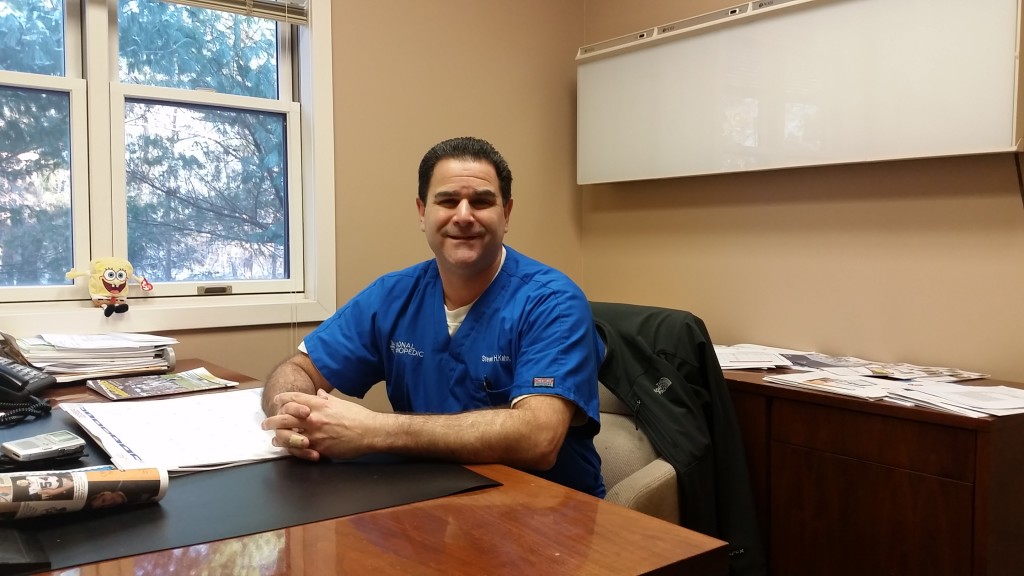DR. KAHN HAS YOUR HIPS COVERED FOREVER
Al Thompson
 Dr. Steven H. Kahn at his desk in his office at 163 Hurffville-Crosskeys Road in Sewell, NJ. Photo by Al Thompson
Dr. Steven H. Kahn at his desk in his office at 163 Hurffville-Crosskeys Road in Sewell, NJ. Photo by Al Thompson CHERRY HILL: Sports competition and exercise has become such a major part of the fabric of everyday life in America. Both men and women, young and old love to compete, love to train.
With sports competitions and training not only come injuries, but the problems, wear and tear on the human body that result from a lifetime of being active.
That is why competent, up-to-date medical treatment – both preventative and post injury – is so important.
Regional Orthopedic Professional Association of South Jersey is considered one of the best in Orthopedic care in the Delaware Valley.
Dr. Steven H. Kahn leads a staff and organization with a 40-year history of serving the needs of patients utilizing the latest advances in orthopedic care, pain management, and podiatry. Their physicians and surgeons are board-certified and keep current on the newest advances in surgical and medical treatment.
Dr. Kahn points to sports specialists Dr. Barry S. Gleimer, Dr. Enrique Garcia Pena, plus Physiatrist TJ Citta for having their finger on the pulse of the growing technology that draws tremendous demand in the athletic community at all levels.
“We have the specialties, but we all treat everything,” Dr. Kahn said in a recent interview. “And we get [patients] in the appropriate hands if they ever need a surgical intervention.”
One area that is advancing deals with hip replacements. This procedure is for active people who are reaching or at middle age who want to continue to stay active for a long time.
In the past, hip replacements were mostly for the elderly, but technology is making it possible for younger people with hip problems to use this procedure with the confidence it will be complication-free for decades.
Zimmer Holdings Inc. recently announced the launch of its new nationwide “Forever Hip” campaign, an effort to draw attention to what the company calls the lifetime wear performance of its new Vivacit-E Vitamin E highly-crosslinked polyethylene.
In a press release, Zimmer Holdings officials wrote that the company believes the hip liners made of the highly crosslinked polyethylene (HXPA) are, according to Matt Monaghan, Zimmer senior vice president, “the first hip replacement technology to demonstrate a lifetime of wear performance based on new material advancements and unprecedented testing.”
Dr. Kahn went on to talk about the specifics of the “Forever Hip” procedure.
“With Zimmer they have ‘Forever Hip’ which is the prep fit, usually on the thigh (thermal) component or the tabular component or the cup..socket component…those are in the hip,” Kahn said. “It’s a ball and socket joint. The polyethylene is high crosslinked, it’s sterilized different now than it was 20 years ago. The Zimmer folks added Vitamin E to prolong the length and longevity of the plastic so it wears longer and lasts longer.”
When your hips start to wear out or deteriorate, the joints don’t care if you were a pro athlete, a mailman, a warehouse worker or someone who manned an assembly line. They just hurt and your quality of life is affected. Hip problems can happen at birth. In the past those kids had a tough time. Now with this new technology, there is real hope for long-term pain relief.
“[Hip problems] can affect anybody, at anytime” Kahn said. “It can be a young child or an adolescent who can have what we call a SCFE (slipped capital femoral epiphysis) where the “head” (of the tibia and thigh-bone) is coming backwards on the actual thigh bone and you have to have surgery.
“Then you can develop dysplasia or arthritis at en earlier age. Some are born with dysplasia meaning the ‘head’ is spherical , it’s not round, it’s misshapen-ed…so now you have a bulb going around in a socket that will cause arthritis at an earlier age.”
Now there is improving technology for everyone.
For children with hip problems, Dr. Kahn said hip replacements are rare. He said he most physicians will perform Osteotomies on children to give them relief. According to hipdysplasia.org, the term Osteotomy, in practice, refers to reshaping a bone. When the pelvic side of the socket is repaired, it is called “pelvic osteotomy”. There are several different types of pelvic osteotomy and the choice depends on the shape of the socket and the surgeon’s experience. When the upper end of the thigh bone is re-shaped, this is called “femoral osteotomy.”
Kahn said hip replacements are not a fountain of youth. What the treatment does, he says, is put people back on track with the natural course of their life.
Since the improvement of hip replacements and the minimal chance for rejection and infection, the average age of his patients is getting younger.
“We used to do hip replacements when people were in their 60s, 70s and 80s…we use to say wait until your 60s to have it done, unfortunately,” Kahn said. “Since I’ve been practicing, for about 15 years, the age in which we’re doing hip and knee replacements is earlier. People are in their 50s, some in their late 40s because they want that improved quality of life and do what they want to do whether it’s work or play with their kids, their grand kids…they don’t want to have that pain.”
Golf, tennis, walking the boardwalk are some of the many activities those have the “Forever Hip” replacement performed can resume.
Like most surgical procedures, having hip replacement procedure is much less intrusive to the human body. Dr. Kahn says he does not use robotic surgery but can perform hip replacement surgery with small incisions that promote a quick recovery. The doctor also explains how the products used in hip replacements have evolved.
“It has improved in a myriad of ways,” Kahn said. “The first would probably be that the polyethylene is manufactured different. It’s sterilized different. It’s highly crosslinked, we’re adding Vitamin E to the product now to make it last longer. If there is less wear, there’s less chance of loosening of the components over time. That is promising.”
Kahn said the surgical procedures now are minimal with just two small incisions rather than in the past, the incisions were much larger.
“There have been different surgical approaches since I’ve been in practice,” Kahn continued. “We have better eyes now as opposed to larger incisions where you are looking at everything.”
Kahn said recovery time has been significantly reduced and patients are back on their feet much faster than just 7-8 years ago.
With opiate addiction problem getting worse every day, Dr. Kahn and his associates are working to make post surgery pain management possible with less dependency on drugs.
The next improvement with any hip replacement or joint replacement surgery is the post operative pain control,” Kahn said. “We’re using things like a ‘drug cocktail’ before the surgery, various medications and we continue that afterward, in addition to injecting long-acting numbing medication so that will last about three days after surgery. If the surgeons use this mode of treatment, they don’t have to be put on what we call a patient-controlled analgesic (PCA) where they hit a button and are getting dilaudid or morphine through their IV. So the post – narcotic medication is less, patients are doing better and getting out of the hospital quicker.”
With better products and ever-improving techniques, the results have improved as well.
“Success rate with hip replacements, in general, is in the 90-95 percent successful,” Kahn said. “Not to say that after surgery the patient doesn’t have to do some work and physical therapy to get their motion and strength back, but overall it’s at a 90-95 percent successful in relieving pain, improving the patient’s function and giving back and improving their quality of life. They can go back and do the things they want to do.”
Dr. Kahn was asked what can be improved even more with hip replacement products and procedures?
“I think what’s going to happen is we’re going to be moving more and more from an in-patient procedure for a total hip or knee (replacement) where the patient comes in and they have surgery, they stay one or two days then either go home or to a rehab facility, to an outpatient surgery,” Kahn said. “Whether it’s done in a hospital setting or done in a surgical setting, they’re going to go home that same day. That’s where we’re going, because the hospital is the worst place for a patient. Hip replacement people aren’t sick, we don’t want them to get infected. We want to do the surgery, stabilize them, then move to the next spot whether it’s to an in-patient rehab facility or to home.” *













